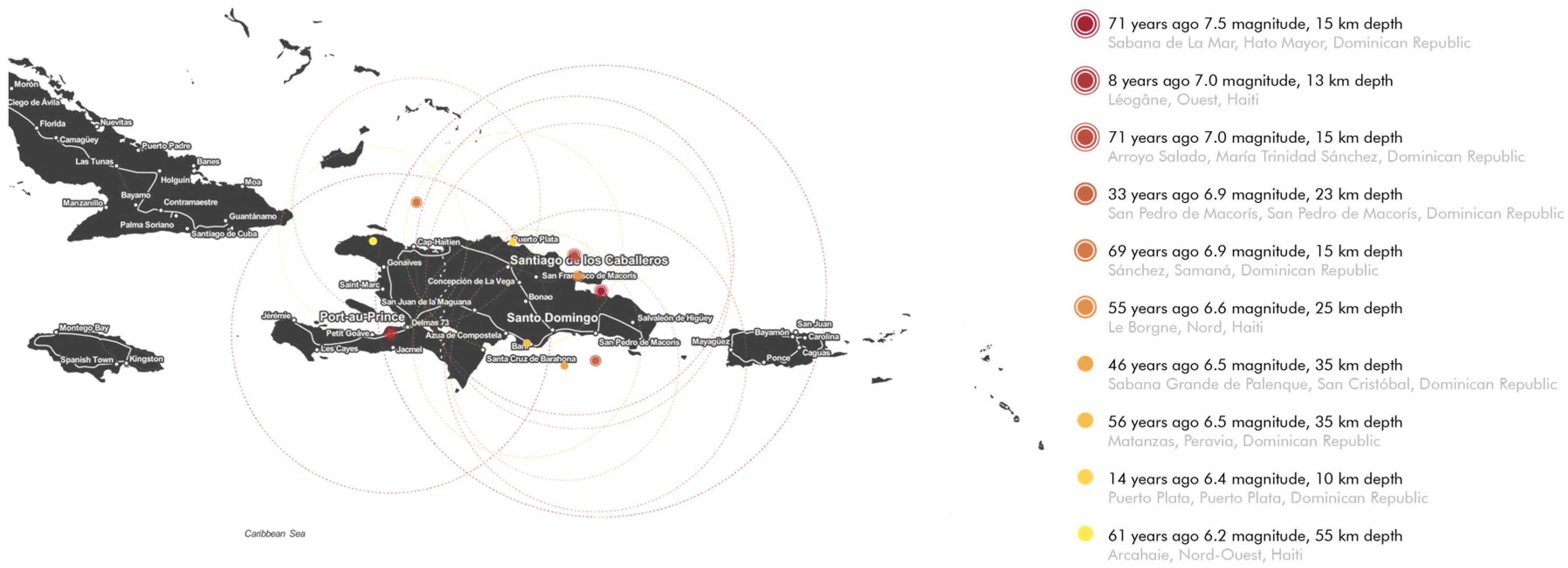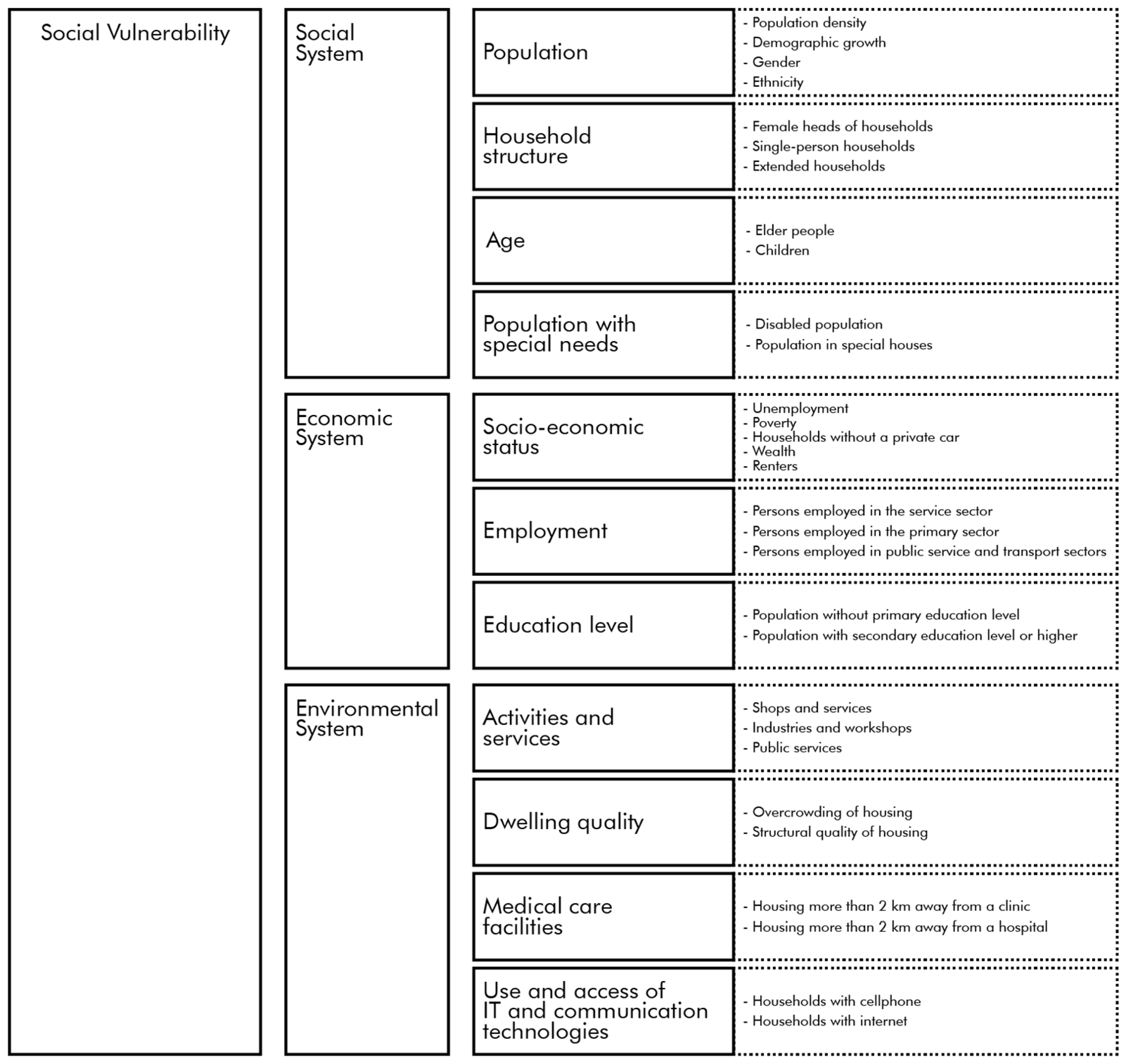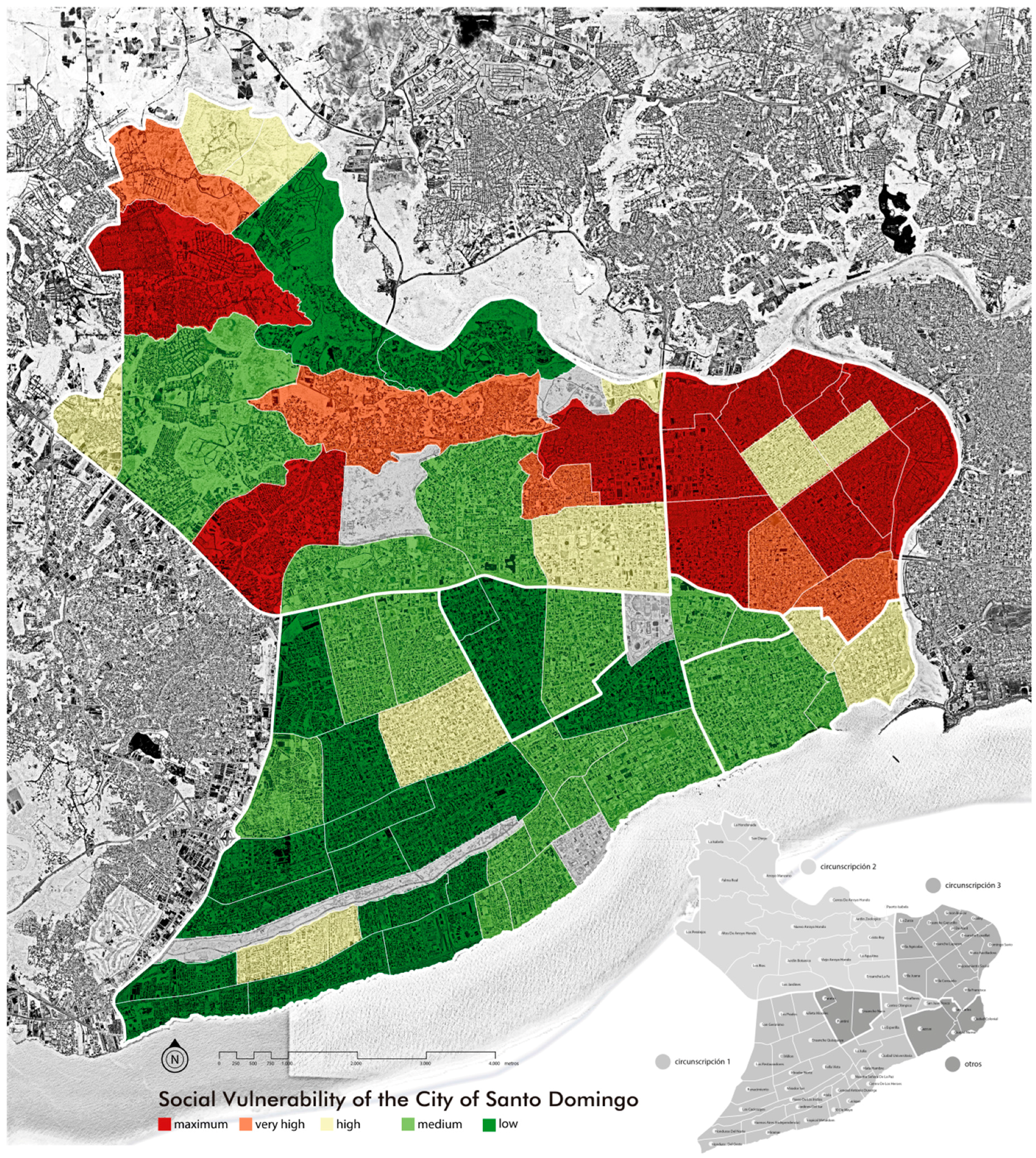Social Vulnerability to Natural Hazards in Urban Systems. An Application in Santo Domingo (Dominican Republic)
Abstract
:1. Introduction
2. Materials and Methods
2.1. Study Area
2.2. A Hierarchical Model for Social Vulnerability: Systems, Components, Indicators
- (1)
- data gathering and selection;
- (2)
- construction of social vulnerability indicators;
- (3)
- elaboration of the SVI;
- (4)
- elaboration of the SVM.
- (1)
- availability of input data and existence of indicators that are already employed in the Dominican context;
- (2)
- spatial representability of the data, so that different degrees of vulnerability can be mapped for the whole metropolitan area;
- (3)
- replicability of the proposed methodology in other cities and/or regions of the DR;
- (4)
- possibility to update and apply the indicators in different timeframes;
- (5)
- dissemination of the final results to local stakeholders and decision-makers.
2.3. Social Vulnerability Index and Social Vulnerability Map
- (1)
- Low vulnerability (values lower than 0.33)
- (2)
- Medium vulnerability (values from 0.33 to 0.37)
- (3)
- High vulnerability (values from 0.37 to 0.46)
- (4)
- Very high vulnerability (values from 0.46 to 0.50)
- (5)
- Maximum vulnerability (values higher than 0.50)
3. Results
- (1)
- Low vulnerability (with an SVI smaller than 0.33), in the neighborhoods presented low indexes in at least two systems, and a medium value for the third. Such neighborhoods can be considered to be less exposed and to have a greater recovery capacity than the others. Medium vulnerability (with an SVI comprised between 0.33 and 0.37) characterized the neighborhoods in which the indexes of at least two systems are nearer to the total mean value and the remaining system deviates from the mean, either positively or negatively. High vulnerability (SVI comprised between 0.37 and 0.46) is visible in the neighborhoods where the indexes of at least two systems are high, while the third system presents a medium or very high index. This category encompasses the neighborhoods with a high exposure, and that consequently can have difficulties during the recovery phase. The Ciudad Colonial falls within this category.
- (2)
- Very high vulnerability is detected in neighborhoods where the indexes of at least two systems are very high, and the third system is characterized by a high index.
- (3)
- Maximum vulnerability (SVI greater than 0.54) describes the neighborhoods that have the greatest values in at least two systems. These neighborhoods are the most exposed and are likely to face more difficulties in the recovery phase, compared to the others.
- (1)
- Circumscription 1 and the surrounding neighborhoods (Poligono Central, Poligono Gazcue and Ciudad Nueva) are generally characterized by overall low and medium social vulnerability. The system that most influences the SVI is the Social one.
- (2)
- Circumscription 2 presents a less homogeneous condition, in which the neighborhoods closer to the Circumscription 3, as well as its northwestern areas, have a greater vulnerability (maximum, very high and high vulnerability). Here, the systems contribute equally to the overall social vulnerability.
4. Discussion and Conclusions
Acknowledgments
Authors Contributions
Conflicts of Interest
References
- Burton, C.G.; Khazai, B.; Silva, V. Social Vulnerability and Integrated Risk Assessment within the Global Earthquake Model. In Proceedings of the 10th National Conference in Earthquake Engineering, Anchorage, AK, USA, 21–25 July 2014; Earthquake Engineering Research Institute: Anchorage, AK, USA, 2014. [Google Scholar]
- UNISDR. Terminology on Disaster Risk Reduction, Geneva. 2009. Available online: http://www.unisdr.org/we/inform/terminology (accessed on 6 June 2017).
- Cutter, S.L.; Mitchell, J.T.; Scott, M.S. Revealing the Vulnerability of People and Places: A Case Study of Georgetown County, South Carolina. Ann. Assoc. Am. Geogr. 2000, 90, 713–737. Available online: http://www.geo.mtu.edu/volcanoes/06upgrade/Social-KateG/Attachments%20Used/SpatialDimensionVulnerability.pdf (accessed on 10 July 2017). [CrossRef]
- UNISDR. Hyogo Framework for Action 2005–2015: Building the Resilience of Nations and Communities to Disasters, Geneva. 2007. Available online: https://www.unisdr.org/we/inform/publications/1037 (accessed on 10 July 2017).
- Levin, S.A. Ecosystems and the biosphere as complex adaptive systems. Ecosystems 1998, 1, 431–436. [Google Scholar] [CrossRef]
- Burton, I.; Kates, R.W.; White, G.F. The Environment as Hazard, 2nd ed.; Guildford: New York, NY, USA, 1993. [Google Scholar]
- Anderson, M.B. Vulnerability to Disaster and Sustainable Development: A General Framework for Assessing Vulnerability. In Disaster Prevention for Sustainable Developmen: Economic and Policy Issue; Munasinghe, M., Clarke, C., Eds.; The International Decade for Natural Disaster Reduction (IDNDR) and The World Bank: Washington, DC, USA, 1995; pp. 41–60. [Google Scholar]
- Blaikie, P.; Cannon, T.; Davis, I.; Wisner, B. At Risk: Natural Hazards, People’s Vulnerability, and Disasters, 2nd ed.; Routledge: London, UK, 1994. [Google Scholar]
- Hewitt, K. Excluded perspectives in the social construction of disaster. Int. J. Mass Emerg. Disasters 1995, 13, 317–339. [Google Scholar]
- Kasperson, J.X.; Kasperson, R.E.; Turner, B.L. (Eds.) Regions at Risk: Comparisons of Threatened Environments; United Nations University Press: Tokyo, Japan, 1995. [Google Scholar]
- Nemec, J.M.; Nigg, F.S.; Siccardi, F. (Eds.) Prediction and Perception of Natural Hazards; Springer: Berlin, Germany, 1993. [Google Scholar]
- Hewitt, K. The idea of calamity in a technocratic age. In Interpretations of Calamity from the Viewpoint of Human Ecology; Hewitt, K., Ed.; Allen & Unwin: London, UK, 1983; pp. 3–32. [Google Scholar]
- Kreps, G.A. Disaster as systemic event and social catalyst: A clarification of subject matter. Int. J. Mass Emerg. Disasters 1995, 13, 255–284. [Google Scholar]
- Smith, K. Environmental Hazards: Assessing Risk and Reducing Disaster, 6th ed.; Routledge: London, UK, 2013. [Google Scholar]
- Protezione Civile. Vulnerabilità alle Calamità Naturali e Mitigazione del Rischio: Le Lezioni del Passato e la via del Futuro. 2008. Available online: http://protezione-civile-italia.blogspot.it/2008/04/vulnerabilit-alle-calamit-naturali-e.html (accessed on 10 July 2017).
- Aroca-Jimenez, E.; Bodoque, J.M.; Garcia, J.A.; Diez-Herrero, A. Construction of an integrated social vulnerability index in urban areas prone to flash flooding. Nat. Hazards Earth Syst. Sci. 2017, 17, 1541–1557. [Google Scholar] [CrossRef]
- Frigerio, I.; Ventura, S.; Strigaro, D.; Mattavelli, M.; De Amicis, M.; Mugnano, S.; Boffi, M. A GIS-based approach to identify the spatial variability of social vulnerability to seismic hazard in Italy. Appl. Geogr. 2016, 74, 12–22. [Google Scholar] [CrossRef]
- Carnelli, F.; Frigerio, I. A socio-spatial vulnerability assessment for disaster management: Insights from the 2012 Emilia earthquake (Italy). Sociol. Urbana Rural. 2016, 111, 22–44. [Google Scholar] [CrossRef]
- Welle, T.; Birkmann, J. The World Risk Index—An Approach to Assess Risk and Vulnerability on a Global Scale. 2015. Available online: https://doi.org/10.1142/S2345737615500037 (accessed on 7 October 2017).
- Nelson, K.S.; Abkowitz, M.D.; Camp, J.V. A method for creating high resolution maps of social vulnerability in the context of environmental hazards. Appl. Geogr. 2015, 63, 89–100. [Google Scholar] [CrossRef]
- Birkmann, J.; Cardona, O.D.; Carreno, M.L.; Barbat, A.H.; Pelling, M.; Schneiderbauer, S.; Kienberger, S.; Keiler, M.; Alexander, D.; Zeil, P.; et al. Framing vulnerability, risk and societal responses: The MOVE framework. Nat. Hazards 2013, 67, 193–211. [Google Scholar] [CrossRef]
- The H. John Heinz III Center for Science, Economics and the Environment. The Hidden Costs of Coastal Hazards: Implications for Risk Assessment and Mitigation; Island Press: Washington, DC, USA, 2000. [Google Scholar]
- Cutter, S.L.; Finch, C. Temporal and spatial changes in social vulnerability to natural hazards. Proc. Natl. Acad. Sci. USA 2008, 105, 2301–2306. [Google Scholar] [CrossRef] [PubMed]
- Warner, K. Perspectives on social vulnerability: Introduction. In Perspectives on Social Vulnerability; Warner, K., Ed.; Selected Papers from the First Summer Academy on Social Vulnerability; UNU-EHS: Bonn, Germany, 2006. [Google Scholar]
- National Research Council. Facing Hazards and Disasters: Understanding Human Dimensions. Committee on Disaster Research in the Social Sciences: Future Challenges and Opportunities; The National Academy Press: Washington, DC, USA, 2006. [Google Scholar]
- Toya, H.; Skidmore, M. Economic development and the impacts of natural disasters. Econ. Lett. 2007, 94, 20–25. [Google Scholar] [CrossRef]
- World Bank & United Nations. Natural Hazards, Unnatural Disasters: The Economics of Effective Prevention; The International Bank for Reconstruction and Development/The World Bank: Washington, DC, USA, 2010. [Google Scholar]
- Sanford, J.E. Developing Countries: Definitions, Concepts and Comparisons; Hardcover; Nova Science Publisher: Hauppauge, NY, USA, 2003. [Google Scholar]
- Corendea, C.; Warner, K.; Yuzva, K. Social Vulnerability and Adaptation in Fragile States. 2012. Available online: http://www.munichre-foundation.org/dms/MRS/Documents/InterSecTions2012_Corendea_FragileStates.pdf (accessed on 10 July 2017).
- Varley, A. Disasters, Development and Environment; Wiley: New York, NY, USA, 1993. [Google Scholar]
- Yucel, G.; Arun, G. Earthquake and Physical and Social Vulnerability Assessment for Settlements: Case Study Avcilar District; World Conference on Earthquake Engineering; WCEE: Lisbon, Portugal, 2012. [Google Scholar]
- Rahman, N.; Ansary, M.A.; Islam, I. GIS based mapping of vulnerability to earthquake and fire hazard in Dhaka city, Bangladesh. Int. J. Disaster Risk Reduct. 2015, 13, 291–300. [Google Scholar] [CrossRef]
- Martins, V.N.; e Silva, D.S.; Cabral, P. Social vulnerability assessment to seismic risk using multicriteria analysis: The case study of Vila Franca do Campo (São Miguel Island, Azores, Portugal). Nat. Hazards 2012, 62, 385–404. [Google Scholar] [CrossRef]
- Zhang, W.; Xu, X.; Chen, X. Social vulnerability assessment of earthquake disaster based on the catastrophe progression method: A Sichuan Province case study. Int. J. Disaster Risk Reduct. 2017, 24, 361–372. [Google Scholar] [CrossRef]
- Dunning, C.M.; Durden, S. Social Vulnerability Analysis Methods for Corps Planning; Report 2011-R-07; U.S. Army Corps of Engineers, Institute for Water Resources: Alexandria, VA, USA, 2011.
- Cutter, S.L.; Boruff, B.J.; Shirley, W.L. Social vulnerability to environmental hazards. Soc. Sci. Q. 2003, 84, 242–261. [Google Scholar] [CrossRef]
- Tierney, K.J.; Lindell, M.K.; Perry, R.W. Facing the Unexpected: Disaster Preparedness and Response; Joseph Henry Press: Washington, DC, USA, 2001. [Google Scholar]
- Putnam, R.D. Bowling Alone: Colapse and Revival of the American Community; Simon & Schuster: New York, NY, USA, 2000. [Google Scholar]
- Cutter, S.L.; Morath, D.P. The evolution of the Social Vulnerability Index. In Measuring Vulnerability to Natural Hazards, 2nd ed.; Birkmann, J., Ed.; United Nations University Press: Bonn, Germany, 2013; pp. 304–321. [Google Scholar]
- The Carribean Development Portal. Available online: http://caribbean.cepal.org/t/developing-countries (accessed on 7 October 2017).
- UNDP. Human Development Report 2013; United Nations Development Programme: New York, NY, USA, 2013. [Google Scholar]
- IMUNA. Available online: http://www.imuna.org/resources/country-profiles/dominican-republic (accessed on 7 October 2017).
- United States Agency for International Development. Dominican Republic Country Development Cooperation Strategy. FY 2014–2018. 2013. Available online: https://www.unpei.org/sites/default/files/e_library_documents/Dominican-Republic%20Country%20Development%20Cooperation%20Strategy_FY14_FY18.pdf (accessed on 7 October 2017).
- UNU HES. World Risk Report, 2016. Available online: http://weltrisikobericht.de/wp-content/uploads/2016/08/WorldRiskReport2016.pdf (accessed on 6 June 2017).
- The World Bank, Dominican Republic. Available online: http://www.worldbank.org/en/country/dominicanrepublic/overview#1 (accessed on 6 June 2017).
- Estudio de la Amenaza Sísmica y Vulnerabilidad Física del Gran Santo Domingo. Available online: http://www.do.undp.org/content/dominican_republic/es/home/operations/projects/crisis_prevention_and_recovery/estudio-de-la-amenaza-sismica-y-vulnerabilidad-fisica-del-gran-s.html (accessed on 10 July 2017).
- Rigillo, M.; Cervelli, E. Mapping Urban Vulnerability: The Case Study of Gran Santo Domingo, Dominican Republic. Adv. Eng. Forum 2014, 11, 142–148. [Google Scholar] [CrossRef]
- Cutter, S.L. (Ed.) American Hazardscapes: The Regionalization of Hazards and Disasters; Joseph Henry Press: Washington, DC, USA, 2001. [Google Scholar]
- Huang, J.; Su, F.; Zhang, P. Measuring Social Vulnerability to Natural Hazards in Beijing-Tianjin Hebei Region, China. Chin. Geogr. Sci. 2015, 25, 472–485. [Google Scholar] [CrossRef]
- Frigerio, I.; De Amicis, M. Mapping social vulnerability to natural hazards in Italy: A suitable tool for risk mitigation strategies. Environ. Sci. Policy 2016, 63, 187–196. [Google Scholar] [CrossRef]
- Solangaarachchi, D.; Griffin, A.L.; Doherty, M.D. Social vulnerability in the context of bushfire risk at the urban-bush interface in Sydney: A case study of the Blue Mountains and Ku-ring-gai local council areas. Nat. Hazards 2012, 64, 1873–1898. [Google Scholar] [CrossRef]
- Prior, T.; Roth, F.; Maduz, L.; Scafetti, F. Mapping Social Vulnerability in Switzerland; ETH: Zurich, Switzerland, 2017. [Google Scholar]
- Chen, W.; Cutter, S.L.; Emrich, C.T.; Shi, P. Measuring social vulnerability to natural hazards in the Yangtze River Delta region, China. Int. J. Disaster Risk Sci. 2013, 4, 169–181. [Google Scholar] [CrossRef]
- De Loyola Hummell, B.M.; Cutter, S.L.; Emrich, C.T. Social vulnerability to natural hazards in Brazil. Int. J. Disaster Risk Sci. 2016, 7, 111–122. [Google Scholar] [CrossRef]
- Guillard-Gonçalves, C.; Cutter, S.L.; Emrich, C.T.; Zêzere, J.L. Application of Social Vulnerability Index (SoVI) and delineation of natural risk zones in Greater Lisbon, Portugal. J. Risk Res. 2015, 18, 651–674. [Google Scholar] [CrossRef]
- Oficina Nacional de Estadistica (ONE). Available online: http://www.one.gov.do/ (accessed on 10 July 2017).
- Mann, P.; Calais, E.; Huerfano, V. Earthquake shakes “Big Bend” Region of North America-Caribbean Boundary Zone. Eos Trans. Am. Geophys. Union 2004, 85, 77–83. [Google Scholar] [CrossRef]
- Ten Brink, U.S.; Bakun, W.H.; Flores, C.H. Historical perspective on seismic hazard to Hispaniola and the northeast Caribbean region. J. Geophys. Res. 2011, 116. [Google Scholar] [CrossRef]
- Mann, P. Global catalogue, classification and tectonic origins of restraining- and releasing bends on active and ancient strike-slip fault systems. In Tectonics of Strike-Slip Restraining and Releasing Bends; Cunningham, W.D., Mann, P., Eds.; The Geological Society: London, UK, 2007; pp. 13–142. [Google Scholar]
- Oficina Nacional De Estadistica (ONE). IX Censo de Población y Vivienda 2010—República Dominicana Sobre población. Available online: http://redatam.one.gob.do/cgibin/RpWebEngine.exe/PortalAction?&MODE=MAIN&BASE=CPV2010&MAIN=WebServerMain.inl (accessed on 10 July 2017).
- Saaty, T.L. Decision Making for Leaders: The Analytic Hierarchy Process for Decisions in a Complex World, 3rd ed.; RWS Publications: Pittsburgh, PA, USA, 2012. [Google Scholar]
- Saaty, T.L.; Vargas, L.G. Models, Methods, Concepts and Applications of the Analytic Hierarchy Process; Springer: New York, NY, USA, 2001. [Google Scholar]
- Saaty, T.L. The Analytical Hierarchy Process; McGraw Hill: New York, NY, USA, 1980. [Google Scholar]
- Cerreta, M.; De Toro, P. Integrated spatial assessment for a creative decision-making process: A combined methodological approach to strategic environmental assessment. Int. J. Sustain. Dev. 2010, 13, 17–30. [Google Scholar] [CrossRef]
- Malczewski, J. GIS and Multicriteria Decision Analysis; John Wiley & Sons Inc.: New York, NY, USA, 1999. [Google Scholar]
- Malczewski, J. GIS-based multicriteria decision analysis: A survey of the literature. Int. J. Geogr. Inf. Sci. 2006, 7, 703–726. [Google Scholar] [CrossRef]
- Campagna, M. (Ed.) GIS for Sustainable Development; Taylor & Francis Group, CRC Press: Boca Raton, FL, USA, 2006. [Google Scholar]
- Cerreta, M.; De Toro, P. Integrated spatial assessment (ISA): A multi-methodological approach for planning choices. In Advances in Spatial Planning; Burian, J., Ed.; InTech: Rijeka, Croatia, 2012; pp. 78–108. [Google Scholar]
- UNISDR. Disaster Risk Reduction Tools and Methods for Climate Change Adaptation. 2004. Available online: http://www.unisdr.org/files/5654_DRRtoolsCCAUNFCC.pdf (accessed on 10 July 2017).
- Breton, M. Neighborhood resiliency. J. Community Pract. 2001, 9, 21–36. [Google Scholar] [CrossRef]
- Putnam, R.D. Making Democracy Work. Civic Tradition in Modern Italy; Princeton University Press: Princeton, NJ, USA, 1993. [Google Scholar]







| Population Density | |
|---|---|
| Description | The indicator shows the population density value (men and women) of resident in each neighborhood (population/hectare) in order to show its distribution in the different urban areas |
| Spatialization Criteria | The classification has been visualized using 5 dimensional classes, according to the Natural Breaks (Jeanks) function |
| Data Source | ONE, IX Censo de Población y Vivienda 2010—Dominican Republic (Processed by Redatam+SP CEPAL/CELADE). Overpopulation [60]. Map database: ONE, shape file: Barrios, Vias, Province |
| Coord. System | WGS84_UTM_Zone 19 |
| Evaluation Direction | + |
| Normalization | In order to allow the comparison between non-homogeneous data at subsequent stages, data have been converted to a values scale between 0 and 1. Higher values of the indicator indicate higher values in standardized elaboration, according to a linear function/benefit |
| Classes | Min Value | Max Value |
|---|---|---|
| <−1 × Std. Dv. | 0 | 0.33 |
| −1 × Std. Dv.; −0.5 × Std. Dv. | 0.33 | 0.37 |
| −0.5 × Std. Dv.; 0.5 × Std. Dv. | 0.37 | 0.46 |
| 0.5 ×Std. Dv.; 1 × Std. Dv. | 0.46 | 0.50 |
| >1 × Std. Dv. | 0.50 | 1 |
© 2017 by the authors. Licensee MDPI, Basel, Switzerland. This article is an open access article distributed under the terms and conditions of the Creative Commons Attribution (CC BY) license (http://creativecommons.org/licenses/by/4.0/).
Share and Cite
Giovene di Girasole, E.; Cannatella, D. Social Vulnerability to Natural Hazards in Urban Systems. An Application in Santo Domingo (Dominican Republic). Sustainability 2017, 9, 2043. https://doi.org/10.3390/su9112043
Giovene di Girasole E, Cannatella D. Social Vulnerability to Natural Hazards in Urban Systems. An Application in Santo Domingo (Dominican Republic). Sustainability. 2017; 9(11):2043. https://doi.org/10.3390/su9112043
Chicago/Turabian StyleGiovene di Girasole, Eleonora, and Daniele Cannatella. 2017. "Social Vulnerability to Natural Hazards in Urban Systems. An Application in Santo Domingo (Dominican Republic)" Sustainability 9, no. 11: 2043. https://doi.org/10.3390/su9112043






